
Ford Fiesta Review

Introduction
When you make the best-selling car in Britain, it's a surefire sign you must be doing something right. The Fiesta’s place at the top of the annual sales charts is almost as certain as death and taxes, and all because it’s probably the best car on sale today. Behind the somehow smart-yet-still-fun design is a really well-sorted hatchback that does everything you want it to and a little bit more. The latest edition, launched in 2017, is great to drive, reliable and well equipped. For all intents and purposes, it’s basically the perfect small car.
Review Sections
Select's rating score* - 4.2 / 5
At a Glance
The Fiesta somehow manages to be all things to all people, with cheap Trend versions for those who just want to get from A to B and fast ST versions for people who want to get from A to B very quickly. There are sporty-looking ST-Line versions and luxurious Vignale models, too, not to mention the slightly more rugged Active variant. You can even have a van version if you need such a thing (or you simply dislike paying tax). All are absolutely brilliant to drive, with strong engines and agility by the bucketload, as well as some clever features.
Key Features
Aside from the driving experience, which is one of the Fiesta’s biggest strengths, a car this popular has to have a wealth of talents. For starters, there’s the Sync 3 infotainment system, which has a big eight-inch touchscreen as standard and is much easier to use than its predecessors.
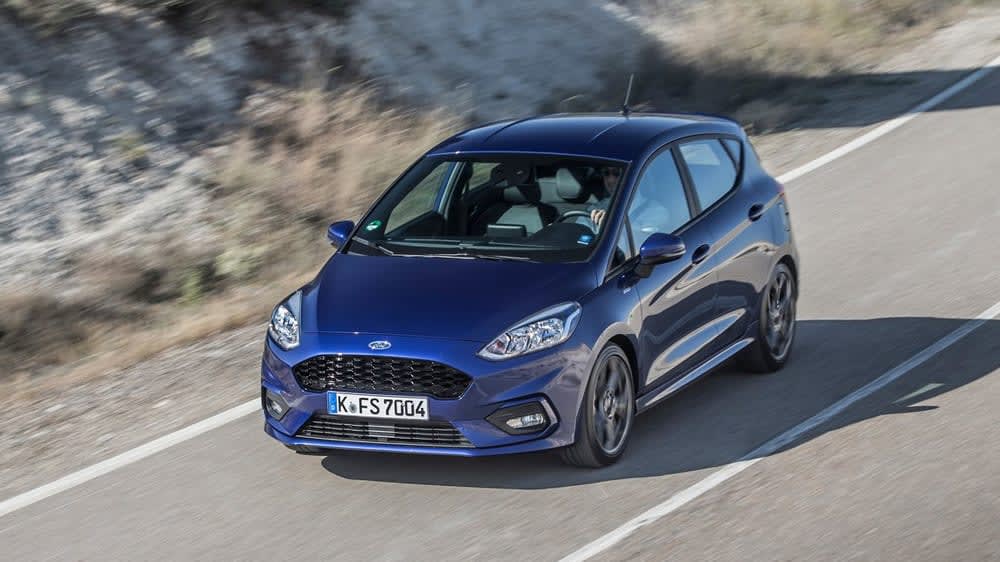
Big icons mean even the stubbiest and clumsiest of fingers can operate everything, and the screen is really clearly laid out. You get some handy options, too, including the driver assistance packs that include all sorts of clever safety kit. A reversing camera and front parking sensors are always handy, but the door edge protectors are the highlight. Like all the best solutions, they’re dead simple, with rubberised plastic strips flipping out to stop the edge of the door scraping on walls, lamp posts or other cars. We’re big fans of the optional heated steering wheel, too.
Performance & Drive
The Fiesta engine range is something of a marvel, dominated as it is by tiny 1.0-litre petrol engines small enough to fit on a sheet of A4. The might not be the biggest, but they pack a punch, offering up to 155hp when paired with mild-hybrid technology.
If you’re looking at an entry-level car, though, you’ll get the 1.1-litre engine with 75hp. With a 0-62mph time of 14.5 seconds, it’s hardly fast, but it does the job. More expensive, but only slightly more powerful is the 85hp 1.5-litre diesel, which is the economy king. A 12.4-second 0-62mph time isn’t exciting, but it does the job without burning through too much diesel.
Arguably, though, it doesn’t do the job quite as well as the 1.0-litre EcoBoost petrol engine, which churns out 95hp in its cheapest guise. Perhaps the sweet spot in the range, though, is the 125hp version of the same engine, which comes with mild-hybrid tech if you go for the manual gearbox. That makes no difference to the power output, but it allows the car to harvest energy normally lost under braking, then use it to help the engine out when it’s under load. All of which makes it the most efficient petrol engine in the range.
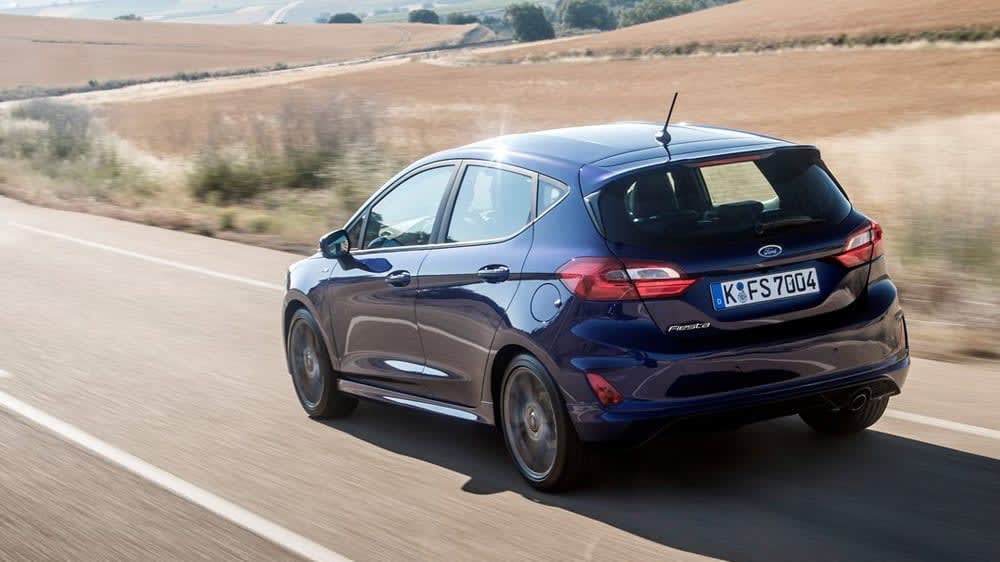
The same technology comes as standard on the high-end 155hp EcoBoost engine, though, and that power offers much-improved performance without damaging the economy. The 0-62mph time dips beneath nine seconds, and you get a top speed of 136mph. At the opposite end of the scale, there’s the 1.5-litre EcoBoost engine, which is only available on the go-faster ST model. With 200hp, that engine is the performance king, offering a 6.5-second 0-62mph time and a 144mph top speed.
But although the performance figures quite rightly suggest the ST is a showstopper, there’s still fun to be had elsewhere in the range. Opt for an ST Line model and the sportier suspension means the handling is very nearly as competent as that of the ST, while the more conventional models aren’t far behind. Whichever version you choose, it’ll be better to drive than any of its direct competitors, with really sharp steering and absolutely stunning manual gearboxes, which are standard across the range (except on the non-hybrid version of the 125hp EcoBoost). Find a good country road and you’ll have a ball.
Yet the Fiesta’s still competent when it comes to the grown up stuff. The ride, for example, is brilliant, despite the sports car handling. Normally, such agility comes with a suspension trade-off, but not in the Fiesta. Sure, the ST and ST Line are on the firm side, but they aren’t too stiff or jiggly when you’re bumbling about town or cruising on the motorway.
The visibility is great, too, and the adjustment in the seats means you can choose whether you sit high, lording it over the other superminis in the supermarket car park, or sit low, pretending you’re in a proper supercar. It’s up to you how you want to sit, but whatever you choose the driving position will be excellent.
Running Costs
Unsurprisingly, the diesel engine is the most economical motor on offer, returning up to 65.7mpg, but none of the Fiesta’s engines is especially thirsty. The mild-hybrids offer the best balance of performance and economy, with high power outputs and economy comfortably in excess of 50mpg, but even the non-hybrid 1.5-litre engine in the ST will return more than 40mpg.
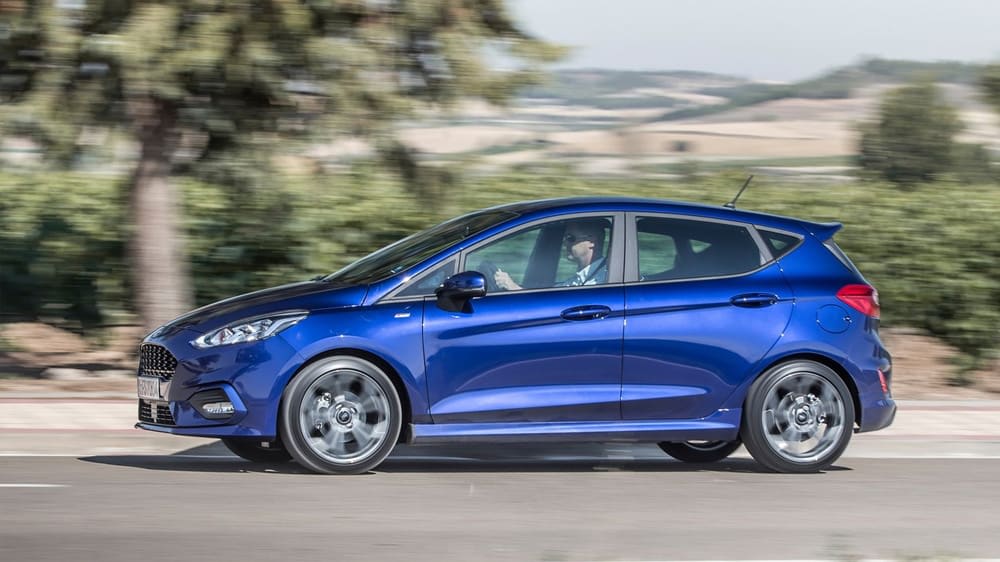
That’s partly because every engine comes with a stop/start system that turns the engine off when you shift into neutral at the lights and partly because those EcoBoost turbocharged engines have been built using engineering witchcraft. The best choice for you will depend on your daily life, but we’d recommend the mild-hybrids to most. If you can afford the outlay, they’ll reward you with decent performance and few drawbacks.
Because the diesel engine is the most fuel-efficient, it also pumps out less carbon dioxide than its stablemates. Officially, it manages between 112 and 119 grams of CO2 per kilometre, depending on the version you’ve chosen. That means company car drivers will pay between 25% or 26% in Benefit-in-Kind tax. But although the diesel looks like the obvious choice for those running company wheels or trying to save the planet, don’t discount the mild-hybrids. The 125hp mild-hybrid will manage CO2 emissions of between 114 and 123g/km, so it’s only just behind the diesel. However, because the mild-hybrid petrol is cheaper to buy than the diesel, it can be cheaper to tax. The joys of the British tax system...
Interior
The cabin has improved dramatically since the last-generation Fiesta, and Ford has really upped its game when it comes to materials. Gone are the old car’s hard plastics, replaced with much softer and much more welcoming soft-touch fittings. The Vignale models are particularly pleasant places to sit, what with their leather upholstery and raft of high-tech features.
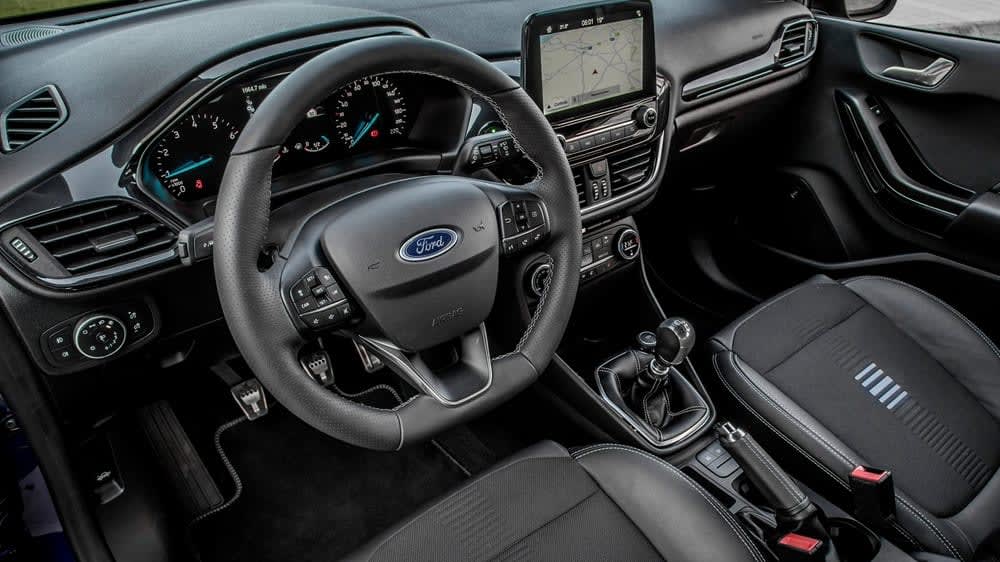
But it isn’t just the materials that have improved. The Fiesta’s more stylish, too, with a less fussy dashboard and a much bigger touchscreen. And it’s more spacious, with extra legroom for those in the back. That means you can now cart four adults around in relative comfort, although long journeys wouldn’t be much fun for taller passengers. But this isn’t really a long journey car, and the school run or trips into town will be absolutely fine.
Technology has been one of Ford’s weak spots in recent years, but that’s all over now. The Fiesta comes with the Sync 3 touchscreen infotainment system, which differs from the old Sync 2 system because it works properly. It’s much easier to use when you’re on the move, thanks to larger icons and a clearer display, and although it has its annoying foibles, it’s now just as competent as the systems in rivals from, say, Peugeot or Vauxhall.

Not only is Sync 3 easier to use, but it’s also well stocked for gadgets. Even basic Trend models come with Apple CarPlay and Android Auto smartphone connectivity software, as well as the FordPass system, which allows communication with a mobile device to access vehicle data and perform some tasks, such as locking the doors. Admittedly, the system is only included for three months, after which a subscription is required, but it’s still a boon in a base model.
Further up the range you get goodies like wireless phone charging and a B&O sound system, which comes with eight speakers dotted around the cabin, including a big subwoofer in the boot.
Practicality & Boot Space
In a small hatchback, space is often at a premium, but the Fiesta doesn’t feel that small – especially from the front. Sure, it’s nimble and manoeuvrable, but it feels solid and roomy. Get in the back and that impression is diminished slightly, but it’s comfortable enough for all but the tallest passengers. If you plan on using those rear seats regularly, and especially if you plan to put children back there, we’d recommend the five-door body shape, which provides easier access. The three-door is fine if you’ll only need the back seats occasionally, but getting in there requires a little agility.
Either way, the boot will measure 311 litres up to the parcel shelf, making it only slightly smaller than that of the previous-generation Focus. Admittedly, practicality was the Achilles heel of the old Focus, so perhaps we shouldn’t read too much into that, but the point stands: the Fiesta is a practical car. No, it doesn’t have the biggest boot in the class, but it’s perfectly competitive, and a few litres here or there is unlikely to tip the scales for most buyers.
That’s partly because there’s more to practicality than boot space, and the Fiesta scores well in terms of storage, with a generous glovebox and decent-sized cubby holes. There’s a well-proportioned storage bin in the centre console and the door pockets are also sensibly sized.
Safety
The Fiesta received a five-star Euro NCAP crash test rating when it was tested back in 2017, and it scored solidly across the board. Basic models don’t get that much in the way of safety kit aside from the usual flock of airbags and stability programmes, but when you move up the range you find much more to go at. Driver alert and traffic sign recognition become standard, for example, and the options list includes pretty much every modern gizmo you can imagine.

There’s autonomous emergency braking that can slam on the anchors if it senses an impending crash, and adaptive cruise control that maintains a safe distance to the vehicle in front. Add that to the mix of parking sensors and rear-view cameras and automatic systems also available and you’ve got some serious back-up to help prevent accidents.
Options
The Fiesta might be a small car, but the model range is big, so bear with us on this. It all kicks off with the basic Trend model, which comes with 16-inch alloy wheels, LED headlights and air conditioning, as well as an eight-inch touchscreen. That houses the Apple CarPlay and Android Auto smartphone connectivity systems, as well as the FordPass modem that allows communication with a smartphone app.
From there, you’ve got a choice of three paths. You could go down the luxury-orientated Titanium route, the sporty ST-Line track or the rugged Active trail. The Titanium path gets you a chrome front grille, automatic lights and wipers, and satellite navigation. You get rear parking sensors, too, along with keyless start, cruise control and leather trim on the steering wheel, gear lever and handbrake.
Carry on down that path and you get to the Titanium X, which gets keyless entry, part-leather seats and automatic climate control, not to mention a B&O sound system and wireless phone charging. And if you really want luxury, you can have the Vignale version with 17-inch alloys, the Vignale grille and leather upholstery, as well as a reversing camera, front parking sensors and the clever door edge protectors, which flip out the moment you open the door.
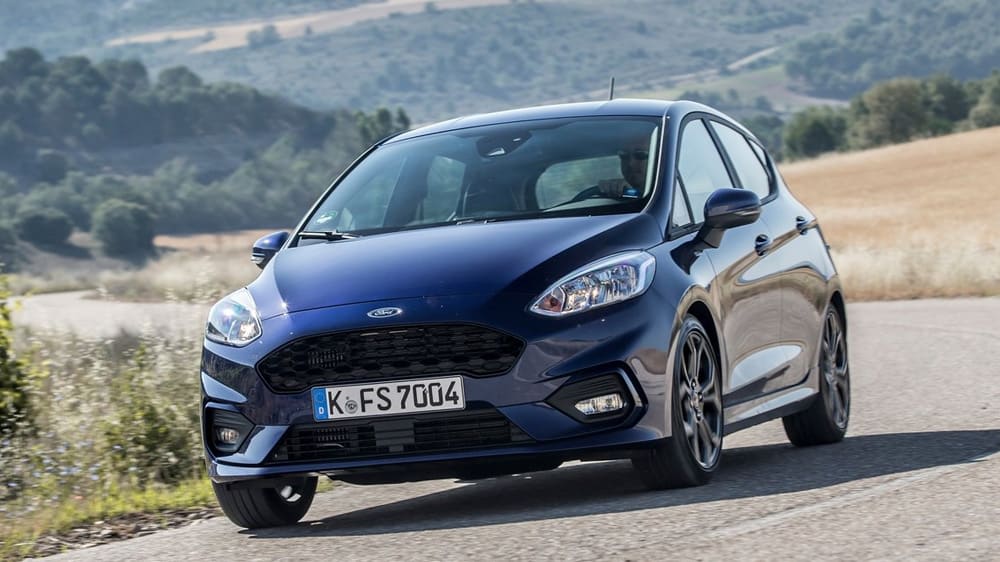
Alternatively, if you chose the more rugged path, you get the Active Edition, which offers a more SUV-inspired look and slightly increased ride height. That car gets 17-inch alloys as standard, plastic body cladding and rear parking sensors, as well as automatic lights and wipers. Like the Titanium, you get leather steering wheel trim and keyless start, but you also get black roof lining. If you want more, there’s always the Active X Edition, which adds 18-inch alloys, roof rails and part-leather seats, plus keyless entry, climate control and the B&O sound system.
The third way is to go for sportiness and choose the ST-Line Edition, which comes with sportier bumpers, sportier suspension and a sportier cabin design. You get satellite navigation, too, and rear privacy glass, as well as automatic lights and wipers and keyless start. Again, there’s an ST-Line X Edition, which adds the B&O sound system, climate control and keyless entry, as well as 18-inch alloy wheels.
But if you take the sporty path to its natural conclusion, you end up with the ST. Available in two levels, the ST comes with the 200hp, 1.5-litre turbocharged engine and unique styling. The ST-2 (no, we don’t know what happened to the ST-1 either) comes with Recaro seats and satellite navigation, while the ST-3 adds leather upholstery, a limited-slip differential and the B&O sound system, plus larger alloy wheels, a rear-view camera and heated front seats. A few special-edition versions of the ST also come and go over time, so watch out for deals on those.
Once you’ve waded through all that, you get a reasonably wide choice of paint colours, with Ruby Red and Desert Island Blue among the best looking. Options aren’t what they once were in the car world, thanks in part to new emissions legislation, but some of the best additions include the Comfort Pack, which offers heated seats and a heated steering wheel (don’t knock it until you’ve tried it) and the openable panoramic glass roof, which makes the cabin feel much airier. If you’ve gone for a basic Trend model, it’s also worth considering the City Pack, which includes rear parking sensors
Who Rivals The Ford Fiesta?
The Fiesta sits in one of the most crowded sectors of the new car market, yet it’s still unrivalled. The Skoda Fabia, Vauxhall Corsa and Volkswagen Polo are all decent hatchbacks, but they don’t have the character and charm of the Fiesta, while the quirky Citroen C3 has the soul without the substance. If you’re desperate for hybrid power, you could choose the Toyota Yaris or Honda Jazz, while those searching for electric power might fancy a Peugeot e-208 or a Renault Zoe.
But the Fiesta’s fiercest competition comes from the Seat Ibiza, Mazda2 and the Mini Hatch. The Seat feels a bit more sensible and grown up, but it doesn’t drive as well, while the Mazda2 offers both those qualities, without the strength in the engine bay. The Mini has the style, the quality and the handling to compete with the Fiesta, but unless you go for the five-door version it’s nowhere near as practical.
Verdict & Next Steps
The Fiesta has this uncanny knack of being whatever you want it to be, so it manages to appeal to pretty much anyone. Whether you’re upsizing or downsizing, single or a family, there’s a place for a Fiesta in your life. It could be your first car, your pride and joy or a runabout to supplement a bigger family bus. It could even be a toy to enjoy on high days and holidays, if you want. Nothing ticks as many boxes for as many people, and that is why the Fiesta is so successful. It’s Britain’s best-selling car because, in many ways, it’s Britain’s best car.
Where to next?
- Car leasing available from £154.76** per month.
- Looking for a great car lease deal? Check out our incredible range of car lease deals.
- Read more about the best hatchbacks to lease: Take a look at our latest Vauxhall Corsa Review or our 2020 Volkswagen Golf Review
- Want to know more about leasing? Take a look at our comprehensive Leasing Guides.
- Interested in everything motoring? Why not catch up on all the latest Car Leasing News.
*Score based on Select’s unique meta score analysis, taking into account the UK’s top six leading independent car website reviews of the Ford Fiesta.
**Correct as of 14/10/2020. Based on 9 months initial payment, 5,000 miles over a 48 month lease. Initial payment equivalent to 9 monthly payments or £1,392.88 Ts and Cs apply. Credit is subject to status.



















